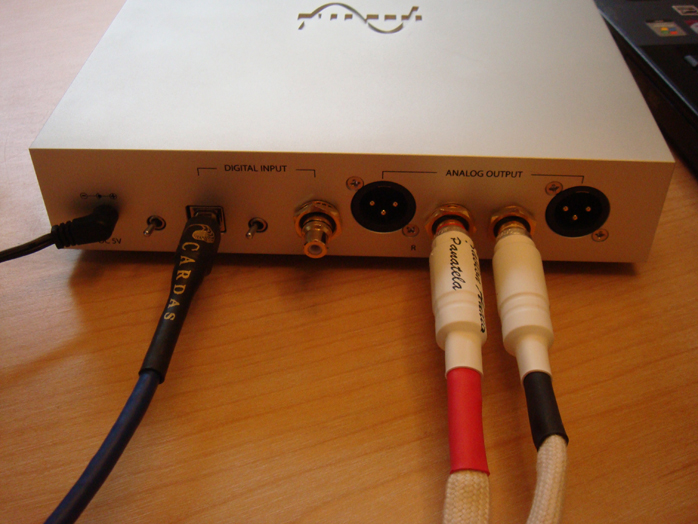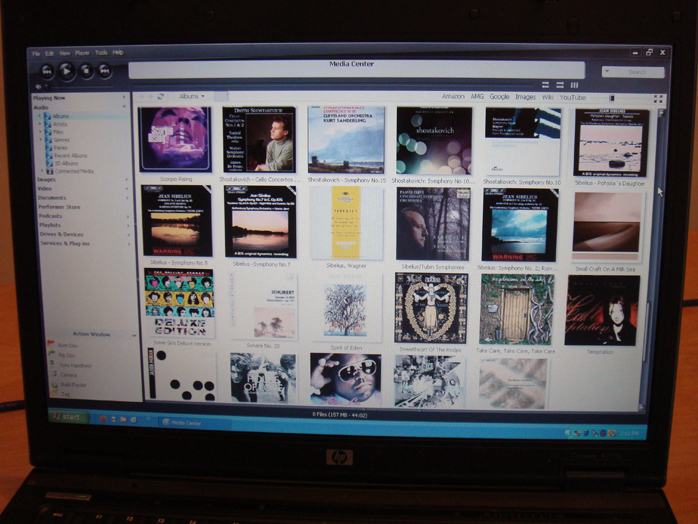This review page is supported in part by the sponsors whose ad banners are displayed below |
 |
 |
|
 |
With the cover removed the majority of the interior consists of solid but empty aluminum which should provide decent vibration and resonance damping. All surface-mounted parts occupy a single circuit board roughly the size of a modest video or sound card as you’d find in a computer expansion slot. The analog output stage includes a number of NE5332 opamps. Although hardly SOTA these days, they seemed more than up to the task based on how good this machine sounded.
USB implementation is asynchronous i.e. the clock of the Calyx controls data flow rather than the computer. The much publicized advantages of asynchronous over adaptive USB transmission are well documented so I won’t delve into it. The USB transceiver is the highly regarded XS1-L1 processor from British firm XMOS. The Calyx has two clocks, one for 44.1/88.2/176.4kHz and another for 48/96/192kHz. |
|
This is considered the superior method of handling those sample rate families. The Calyx thus locks to all rates between 16-bit/44.1kHz and 24-bit/192kHz unlike many other DACs some of which are far more expensive.
|
 |
The XMOS chip is supported natively by Apple’s OS X. Plug and play and you should be good to go. For Windows users Calyx ships a CD-ROM containing a Thesyscon ASIO driver. Installation of the driver plus a little utility program that indicates sampling rate output was a snap and posed no obstacles. Aesthetically the Calyx was a beautiful piece of gear and would complement a Mac Mini perfectly. Operationally it was flawless. I had no issues whatsoever installing the ASIO driver or using it with J. River Media Center.
|
|
|
Confession. At the present time I hadn’t felt a real need to ditch my CEC transport and delve fully into computer audio. If it ain’t broke why fix it? Besides I’m not sure computers are quite there sonically. Furthermore due to the high-speed transitory nature of the computer industry I’d recommend exercising some fiscal restraint on any potential USB DAC purchase. Already USB is fading in favor of interfaces like Thunderbolt. Who knows how long USB will be supported? What I’d like to see from DAC manufacturers are modular units where owners can purchase upgrade cards as new connectivity options become available.
I also have little interest in so-called music servers. The notion of spending $20,000 or even $5,000 for a glorified computer that will be obsolete in a few months seems plain nuts. And I need to buy an iPad to control the damn thing? Great, a $500 optional remote. As such I have been content to sit on the sidelines and occasionally dip my toes into these waters with an inexpensive laptop. Whenever my CEC transport eventually gives up the ghost, I’ll consider purchasing a higher-spec PC or MAC or perhaps build my own audio PC. I’ve sourced parts and assembled my own computers for years. Building a PC optimized for audio would be fun. Granted it’s not for everyone but I can guarantee you’ll quickly learn how computers work!
|
 |
After appearing to unzip my fly on computer audio, the one aspect I’ve definitely taking advantage of already is the steadily increasing availability of downloadable music at CD resolution or higher. While pricing continues to be outrageous in some circles, look carefully and you’ll find terrific value often cheaper than physical media as it should be. A good portion of my music purchases these days comes from online download music sites such as Qobuz and eclassical. However I burn all 16/44 albums onto CD-R for playback on my CEC/MIT/Audiomat combo which still sounds better to me than 16-bit/44.1kHz WAV or FLAC files played back on my HP laptop feeding my Audiomat Tempo 2.6 DAC via M2Tech’s hiFace USB-S/PDIF interface. Therefore I use the latter combo strictly for hi-rez playback i.e. 24-bit/88.2kHz and up. Alas my Audiomat Tempo 2.6 DAC doesn’t have a USB input. While the hiFace works well for $150, I knew there was room for improvement.
|
|
|
For me true nirvana in computer audio is the promise of breaking free from the shackles of 16-bit/44.1kHz and the widely variable sound quality between various physical CD pressings. With true native high-resolution audio i.e. 24-bit/88.2kHz and up, I hear substantial gains in definition, openness, nuance and finesse particularly in the top end. Music just sounds more natural and real. I get that much closer to the artistic intent. Provided that recording company weasel suits don’t screw it up with DRM, we finally have access to the master tape. That’s pretty cool.
|
 |
However I advise caution when presented with claims of so-called high-resolution recordings that really are just remastered or upsampled 16-bit/44.1kHz originals. Remastering older recordings is big business these days as the major record companies continue to stumble their way into irrelevance. Many remasters sound awful usually as a result of excessive compression which is used to make them sound louder and more modern - or so the argument goes. A perfect example is the 24-bit/88.2kHz remaster of The Rolling Stones’ 1978 classic Some Girls which I downloaded primarily for the bonus tracks. It was never a great sounding album to start with but the music is among the Stones’ best.
|
 |
  |
 |